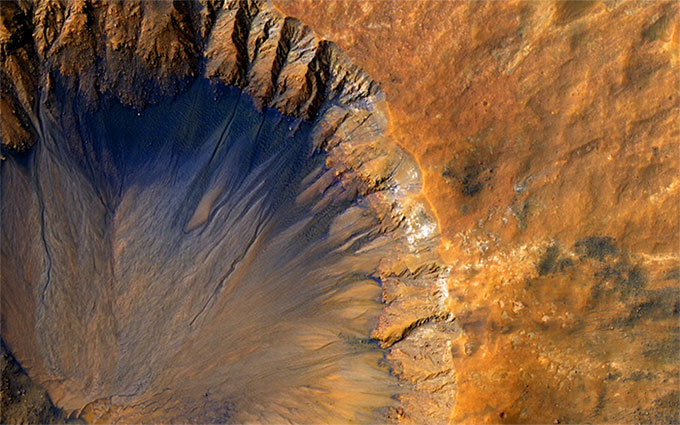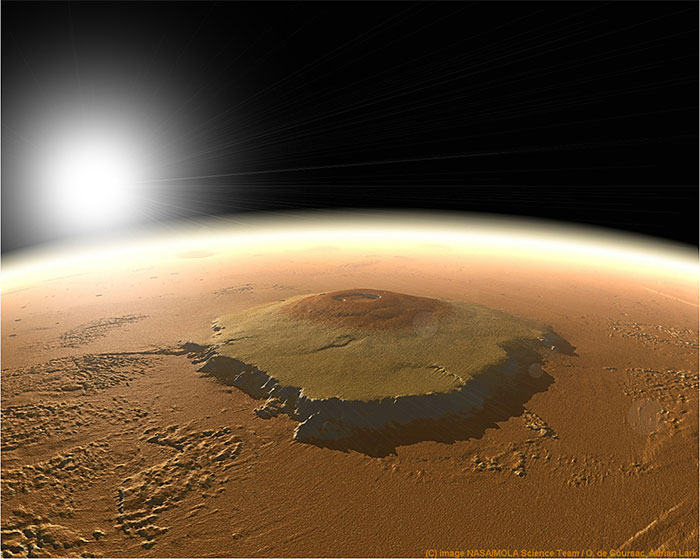Top 8 destinations that promise a boom in Mars tourism in the future
Mars is a planet of spectacular contrasts - the largest giant volcanoes in the solar system, the deep valleys. But it will be a great place to explore for future visitors.

The impact crater in the Sirenum Fossae region on Mars, photographed by NASA's Mars Reconnaissance Orbiter on May 30, 2015. (Photo: NASA)
Landing sites for future Mars missions will likely have to be flat lands, for safety reasons, but if it takes more time, we might be able to get visitors to land in some areas. more interesting geology.
Here are some fascinating sites that future Mars visitors can visit.
1. The giant volcano Olympus Mons
Olympus Mons is the most extreme volcano in the solar system. Located in the Tharsis volcanic region, it is about the size of the US state of Arizona. The height of this volcano is 25km, almost 3 times the height of Mount Everest on Earth (8.9km).

The volcano Olympus Mons is like a giant shield. (Photo: NASA)
Olympus Mons is a giant shield volcano, formed after lava slithered down its slopes.
This also means that the mountain is easily accessible to adventurers, as its average slope is only 5%. At the summit of Olympus Mons is a spectacular depression, about 85km wide, formed by magma chambers that lost lava (perhaps during an eruption) and collapse.
2. Tharsis . Volcano
While climbing Olympus Mons, visitors should go around to see some of the other volcanoes in the Tharsis area.

Several giant volcanoes in the Tharsis region of Mars in this image from NASA's Viking 1 spacecraft.
According to NASA, Tharsis has 12 giant volcanoes in an area about 4,000km wide.
Like Olympus Mons, these volcanoes tend to be much larger than those on Earth, presumably because Mars has a weaker gravitational pull, allowing volcanoes to grow taller. These massive volcanoes may have erupted in about 2 billion years, or half the history of Mars.

The 1,700km-wide Tharsis area contains the Olympus Mons volcano (top left) and several other volcanoes in the image that have been color-coded by topography. (Photo: NASA).
The image above shows the area east of Tharsis, taken by the Viking 1 in 1980. To the left, top to bottom, left is the giant Olympus Mons; To the right and down are three shield volcanoes about 25 km high, including: Ascraeus Mons, Pavonis Mons and Arsia Mons.
3. Valles Marineris . Gorge

The Valles Marineris Canyon streak is 3,000km across the surface of Mars. (Photo: NASA)
Mars not only has the largest volcano in the solar system, but also the largest canyon. Valles Marineris is about 3,000km long, about four times longer than the Grand Canyon in the US, with a length of 800km.
Researchers are not sure how Valles Marineris formed, but there are several theories about its formation. Many scientists believe that when the Tharsis region was formed, it contributed to the development of Valles Marineris.
Lava moving through the volcanic region pushed the crust upwards, causing the crust to break into faults. Over time, these fractures develop into Valles Marineris.
4. Mars Pole

Mars has two icy regions at its poles.
Mars has two icy regions at its poles, with slightly different compositions; The north pole (pictured) was closely studied by the Phoenix lander in 2008, while observations of the south pole were made by orbiters.
During the winter, temperatures near the North and South poles of Mars are so cold, that carbon dioxide (CO2) condenses out of the atmosphere into ice on the planet's surface.
This process reverses during the summer, when CO2 sublimates back into the atmosphere. Carbon dioxide disappears completely in the Northern Hemisphere, leaving behind an ice cap. But some CO2 ice sheets still exist in the Southern Hemisphere. All of these ice movements have a major effect on the climate on Mars, creating wind and other effects.
5. Gale Crater and Mount Sharp

Made famous after the crash of the Curiosity spacecraft in 2012, Gale Crater is the place to hide evidence of the existence of water in the past.
The Curiosity rover stumbled upon a stream bed within weeks of landing, and discovered more impressive evidence of water during its journey along the crater's bottom. Curiosity is currently exploring a nearby volcano called Mount Sharp (or Aeolis Mons) and examining the geological features of each of its strata.
One of Curiosity's more exciting discoveries has been the numerous discoveries of complex organic molecules in the region. In 2018, NASA announced results that these organic substances were detected inside 3.5 billion-year-old rocks.
Along with the organics results, the researchers say the rover also detected seasonal variations in atmospheric methane concentrations. Methane is an element that can be made by bacteria, as well as by geological phenomena, so its discovery suggests it could be a sign of life.
6. Medusae Fossae

The formation of Medusae Fossae may have come from volcanic eruptions.
Medusae Fossae is one of the strangest places on Mars. Some have even speculated that the terrain was caused by an accident caused by a UFO (unidentified flying object).
The more reliable theory is that it is a giant volcanic deposit, an area of one-fifth the size of the United States. Over time, the wind has turned the rocks here into beautiful shapes. However, scientists need to do more research to understand how the volcanoes formed
Medusae Fossae.
A 2018 study suggested that the formation of Medusae Fossae may have come from extremely large volcanic eruptions that took place hundreds of times over 500 million years on Mars. These eruptions will warm the Red Planet's climate as greenhouse gases from the volcano drift into the atmosphere.
7. The 'flowing water' slope of Hale . crater

Periodic slopes on Mars.
Mars is home to strange geological regions, known as recurring slope lineae (RSL), which tend to form on steep crater sides during warm weather.
However, it is difficult to find these RSLs. The images here taken from Hale crater show spots where spectroscopy has detected signs of hydration.
In 2015, NASA initially announced that hydrated salts should be indicative of surface water, but later research said RSLs could be formed from atmospheric water or dry sand streams.
In fact, we can get up close to these RSLs to see what they really are. But that's also a challenge, because if the RSL actually contained foreign bacteria, we wouldn't want to get close to it for fear of infection. Future Mars explorers may have to admire this mysterious terrain from a distance using binoculars.
8. "Ghost Dunes" of Noctis Labyrinthus and Hellas . Basin

Mysterious sand dunes on Mars. (Photo: NASA)
Today, Mars is a planet mostly shaped by wind, as the water has evaporated as its atmosphere thins. But we can see plenty of evidence of past water sources, such as regions of "ghost dunes" found in the Noctis Labyrinthus and Hellas basins. The researchers say these areas used to have sand dunes tens of meters high. Later, the dunes were flooded with lava or water, which preserved the base while the top was eroded.
Ancient sand dunes like these show how winds once blew on ancient Mars, providing climatologists with some hints about the Red Planet's ancient environment. In an even more interesting twist, there may be bacteria hiding in the areas sheltered by these dunes, keeping them safe from radiation and from being carried away by the wind.
- Putting people on Mars: The dream is about to come true
- The sun changes, Mars is easier to live than Earth?
- Risks face when living on Mars
- Future model on Mars in the future
- Anh newspaper chooses Vietnam as the best place to travel alone
- 10 spectacular destinations are about to disappear on Earth
- Think about 'future' farms on Mars
- Announced 3 houses on the Moon and Mars
- The ice sheet on Mars can provide water for future residents
- Latest Mars map
- 5 reasons why people need to go to Mars
- Be overwhelmed by images of life on Mars that may appear in the future
 Announced 3 houses on the Moon and Mars
Announced 3 houses on the Moon and Mars Science proves: Mars also knows 'deflated'
Science proves: Mars also knows 'deflated' Elon Musk announced the price for a Mars trip was 11.6 billion VND, free of charge
Elon Musk announced the price for a Mars trip was 11.6 billion VND, free of charge NASA discovered strange 'gate' on Mars, is the hiding place found?
NASA discovered strange 'gate' on Mars, is the hiding place found?